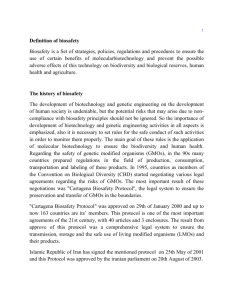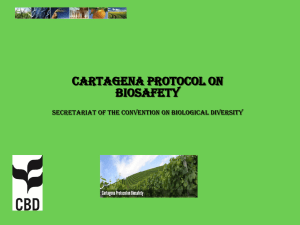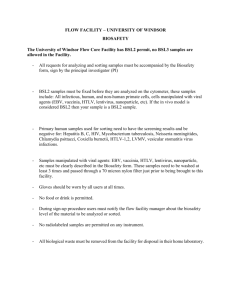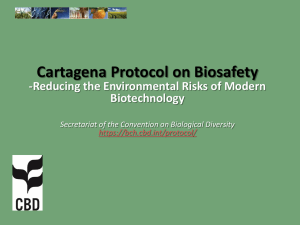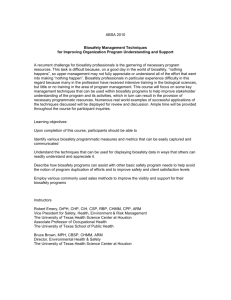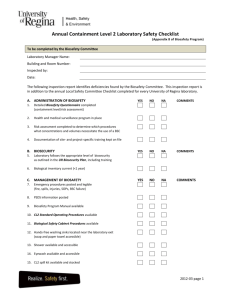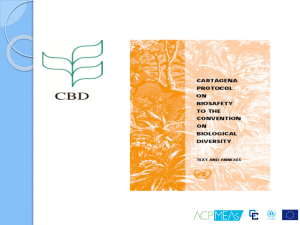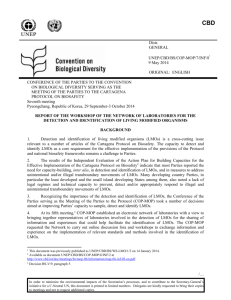Implementing National Biosafety Framework Project
advertisement
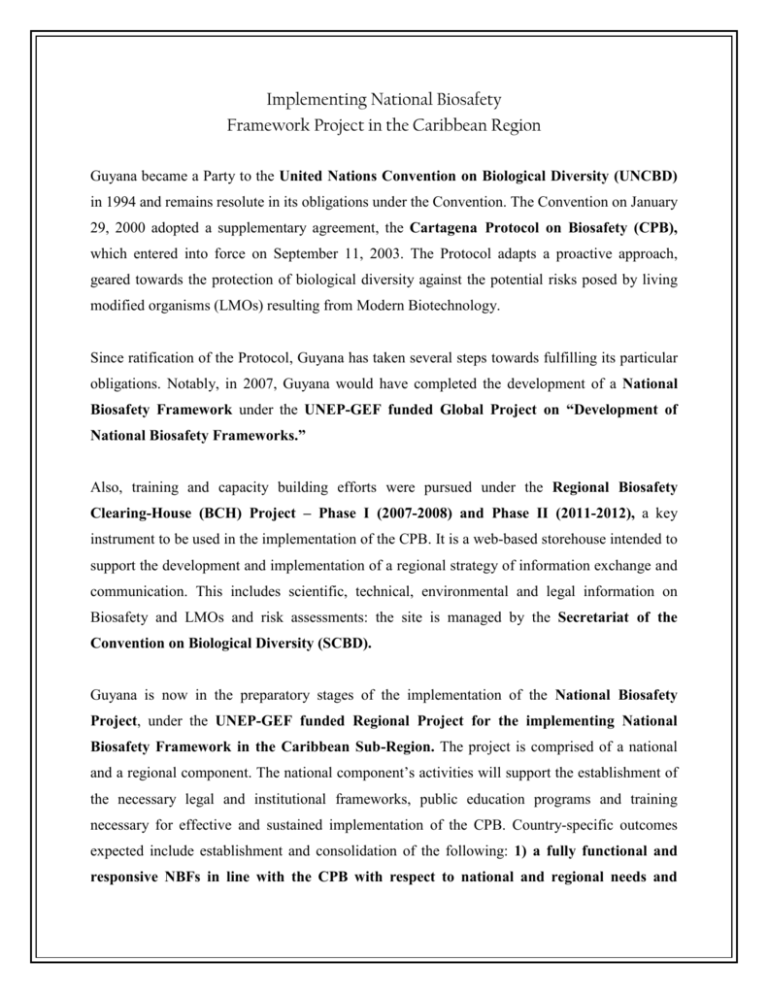
Implementing National Biosafety Framework Project in the Caribbean Region Guyana became a Party to the United Nations Convention on Biological Diversity (UNCBD) in 1994 and remains resolute in its obligations under the Convention. The Convention on January 29, 2000 adopted a supplementary agreement, the Cartagena Protocol on Biosafety (CPB), which entered into force on September 11, 2003. The Protocol adapts a proactive approach, geared towards the protection of biological diversity against the potential risks posed by living modified organisms (LMOs) resulting from Modern Biotechnology. Since ratification of the Protocol, Guyana has taken several steps towards fulfilling its particular obligations. Notably, in 2007, Guyana would have completed the development of a National Biosafety Framework under the UNEP-GEF funded Global Project on “Development of National Biosafety Frameworks.” Also, training and capacity building efforts were pursued under the Regional Biosafety Clearing-House (BCH) Project – Phase I (2007-2008) and Phase II (2011-2012), a key instrument to be used in the implementation of the CPB. It is a web-based storehouse intended to support the development and implementation of a regional strategy of information exchange and communication. This includes scientific, technical, environmental and legal information on Biosafety and LMOs and risk assessments: the site is managed by the Secretariat of the Convention on Biological Diversity (SCBD). Guyana is now in the preparatory stages of the implementation of the National Biosafety Project, under the UNEP-GEF funded Regional Project for the implementing National Biosafety Framework in the Caribbean Sub-Region. The project is comprised of a national and a regional component. The national component’s activities will support the establishment of the necessary legal and institutional frameworks, public education programs and training necessary for effective and sustained implementation of the CPB. Country-specific outcomes expected include establishment and consolidation of the following: 1) a fully functional and responsive NBFs in line with the CPB with respect to national and regional needs and priorities; 2) a functional national systems and availability of services for handling requests, performing risk assessment, detecting living modified organisms (LMOs), decision-making and for performing administrative tasks; 3) functional systems for monitoring environmental effects and enforcement; 4) functional national systems for biosafety information management and stimulating public awareness, biosafety education, and participation in the decision-making process. The Regional component will serve to enhance the National component and generating a consensus on the mechanism with respect to the obligations under the Protocol at the regional level. The project has a duration of forty-eight (48) months with complete fulfillment expected in June of 2015. It would require coordination between government agencies which will see the adoption of policies, laws, and supporting regulations, through their varying mandates and expertise. A bottom-up approach is taken allowing for Regional and International collaboration, garnering of technical support and sharing of experiences, while addressing the needs within the region as it relates to biosafety. The University of the West Indies (UWI) takes the lead as the Regional executing organization (LEA), while the Environmental Protection Agency (EPA) with the support of the Government of Guyana is the National Executing Agency (NEA) to the project. Guyana and eleven other countries, namely, Antigua & Barbuda, Bahamas, Barbados, Belize, Dominica, Grenada, St. Kitts & Nevis, St. Lucia, Suriname, Trinidad & Tobago, and St. Vincent & the Grenadines will be participating in this project. Nationally, project implementation will garner the technical resources of several national stakeholders. In recognition of the importance of safeguarding its genetic biodiversity, Guyana has established a Protected Areas Commission, facilitating two (2) new declarations in 2011. Incredible effort has also been invested in the continued conservation of Guyana’s forest and associated genetic resources for which the Low Carbon Development Strategy (LCDS) was also developed. The use of biotechnology in Guyana thus far has not proven to be a treat to biodiversity or human health. It has been used primarily in the agriculture sector, partially due to the strong economic support provided to Guyana’s economy from agricultural products and raw materials. The main forms of biotechnology practiced in Guyana are plant tissue culture and natural products chemistry involving key agencies, The National Agricultural Research and Extension Institute (NAREI), Banks DIH Ltd. and Demerara Distillers Ltd and the Institute of Applied Science and Technology (IAST). Despite these initiatives, the application of biotechnologies employed in the industrial, medical and environmental sectors have not been extensive due to the lack of current technologies and limited expertise. Guyana’s economy is in transition, and modern biotechnology must be employed in the future to respond to the needs of the society. It is important that Environmental Biotechnology also be readily available in Guyana as a precautionary measure to respond to the needs of the mining sector, should the need arise for remediation effort. Also, ever increasing trade in the Caribbean region and efforts to reduce trade barriers under the CSME presents a significant threat to the biodiversity of the region, principally in the form of undetected gene flow. Undetected and unregulated entry of LMOs into the region is likely to continue in the absence of common transboundary control system, insufficient information to inform decision-making and risk management measures, weak public awareness of the risks created by modern biotechnology, and weak legal and instructional frameworks for effective management of such risks. Further, the threat to the Caribbean region’s significant biodiversity from LMOs that could be introduced, either intentionally or by accident, is exacerbated by a limited capacity to identify, assess or manage such risks, as highlighted in the inventory and assessment work carried out by countries in preparing their NBFs, and an assessment of national biosafety capacities that was undertaken as part of project preparation activities. In the light of this, there is a need to ensure safe transfer of Genetically-modified Organisms (GMOs) and Living Modified Organisms (LMOs) as specified in the Cartagena Protocol on Biosafety. National frameworks are being implemented to foster the safe transfer of LMOs that are likely to pose adverse effects on conservation and sustainable use of biodiversity, with supporting procedures for advanced informed agreements.
